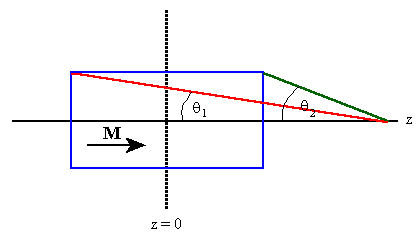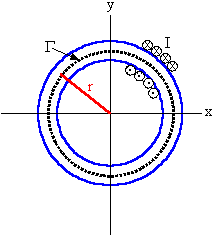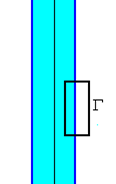Magnetic materials
Problem:
A ferromagnet is one for which the magnetization M(r)
is given and the free current density jf = 0.
(a) For this case, write down the relevant Maxwell
equations for the magnetic induction B and the magnetic field
H in
the absence of any time-varying electric field.
(b) For this ferromagnet relate B,
H, and
M.
(c) Define the magnetic scalar potential
ΦM and state why this is a
valid concept in this case.
(d) Show that
∇2ΦM
can be expressed in terms of M by a Poisson equation and give its formal
solution in the absence of boundaries by comparing with the solution of the electrostatic Poisson equation.
Solution:
Problem:
A sphere of linear magnetic
material is placed in an originally uniform magnetic field magnetic field B0.
Find the new field inside the sphere.
Solution:
- Concepts:
The uniqueness theorem, boundary conditions, B =
μH.
- Reasoning:
The external magnetic field will magnetize the sphere. The magnetic field of a
uniformly magnetized sphere is uniform inside the sphere (B = 2Mμ0/3)
and a pure dipole field outside the sphere. Assume that the total field inside
the sphere is the superposition of the field of a uniform magnetized sphere and
the constant external field B0. The superposition of these
two fields fulfills all the boundary conditions for B,
(B2 - B1)·n2
= 0, (B2 -
B1)·t2
= μ0k·n,
on the surface of the sphere.

We have a unique solution as long as inside B =
μH =
μ0(1 +
χm)H inside the
sphere.
B = μH determines the
magnetization surface current density.
- Details of the calculation:
Bin = B0 + 2Mμ0/3,
μHin =
Bin,
M = χmHin
= (χm/μ)Bin.
(1 - 2μ0χm/(3μ))Bin
= B0. Bin
= B0(3 + 3χm)/(3 + χm).
The magnetic moment of the sphere is m = (4πR3/3)M
= (4πR3/3)(χm/μ)Bin,
where R is the radius of the sphere. For r > R we have
Bout = B0 + (μ0/4π)[3(m∙r)r/r5
- m/r3].
Problem:
A small spherical cavity of radius a is made in a permanent magnet of
uniform magnetization M. Find
B and
H at the center of the
cavity.
Solution:
- Concepts:
The principle of superposition
- Reasoning:
Maxwell's equations are linear equations. The principle of
superposition holds. We may write
Bcavity = Bmaterial -
Buniformly
magnetized sphere.
- Details of the calculation:
For a uniformly magnetized sphere we have:
Bout = pure dipole field,
Bin =
uniform, in the direction of M.
Let M = Mk,
m = (4/3)πa3M.
Bout = (μ0/4π)[3(m∙r)r/r5
- m/r3].
Bout_θ = (μ0/4π)(m/r3)sinθ,
Bout_r = (μ0/4π)(2m/r3)cosθ.
Bin = Bink.
B is continuous
at r = ak.
Bin = (μ0/4π)(2m/a3)k
= (μ0/4π)(8/3)πM.
We therefore have Bcavity =
Bmaterial - (μ0/4π)(8/3)πM.
Bmaterial depends on the shape of the magnetized material.
Hcavity =
Bcavity/μ0.
Problem:
A short cylinder (length l and radius a) of iron is magnetized
along the axis of the cylinder. Calculate H and
B on the axis,
both inside and outside.
Solution:
- Concepts:
Magnetization M, magnetization current densities, the
field of a solenoid
jm
=
∇×M,
km
=
M×n.
- Reasoning:
Magnetization always results in magnetization current densities.
Uniform magnetization results in surface current densities. The uniform
magnetization of a cylinder results in a surface current density like that of
a solenoid.
- Details of the calculation:
For a solenoid we have
Bz = (μ0In/2)(cosθ1
- cosθ2).
(We choose the symmetry axis to be the z-axis,)

(I*n) is the current per unit length, i.e. the surface current density.
For the magnetized cylinder we therefore have on the axis
Bz = (μ0km/2)(cosθ1
- cosθ2).
km = M (z/z) ×(ρ/ρ) = M (φ/φ). Bz = (μ0M/2)(cosθ1
- cosθ2).
If the center of the cylinder is at the origin then
cosθ1 = (z + l/2)/(a2 + (z + l/2)2)½, cosθ2
= (z - l/2)/(a2 + (z - l/2)2)½.
H = B/μ0 outside.
H = B/μ0 -
M
inside. H = k[(M/2)(cosθ1
- cosθ2) - M] inside.
At z = l/2 + e (e --> 0)
we have H = k(M/2)cosθ1,
H points into the positive z-direction.
At z = l/2 - e (e --> 0)
we have H = k[(M/2)cosθ1 - M],
H points into the negative z-direction.
H reverses direction at the boundary
Remember:
The same current distributions produce the same fields.
The normal component of
H is not continuous, ∇∙H ≠
0 in general.
Problem:
A coil of N turns is wrapped around an iron ring of radius d
and cross section A (d >> A½). Assume a
constant permeability μ >> 1 for the iron.
(a) What is the magnetic flux
Φ = ∫B∙dA as a function of
current I?
(b) If a gap of width b, (b2 << A) is cut in the
ring, what is the flux for the same current I?
(c) What is the field energy in the iron and in the gap?
(d) With such a gap in the ring, what is the self inductance?
Solution:
- Concepts:
Ampere's law for H,
∮Γ
H∙dl = Ifree through
Γ, H = B/μ0 -
M,
magnetic field energy, self inductance
- Reasoning:
The problem has enough symmetry to let us calculate H from Ampere's law of H
alone.
Iron is not a lih material, but we assume that for the field strength B given
in the problem we may write B = μH.
After a small gap has been cut into the ring we use the boundary conditions
for B to find B and
H in the gap. We use the energy
density u = ½B∙H to find the stored
energy.
- Details of the calculation:
(a) H and B point into the φ
direction, H = NI/(2πr), B =
μNI/(2πr).

If d >> A½, then B inside the coil is nearly constant, B =
μNI/(2πd).
Flux
Φ = ∫BndA,
Φ = μN2IA/(2πd), Φ is proportional to I.
(b) If b2
<< A, then Biron
≈ Bgap = μ0Hgap,
because the normal component of B is continuous.
Hiron(2πd - b) + Hgapb = NI,
(B/μ)(2πd - b) + (B/μ0)b
= NI, from Ampere's law for H.
B = μμ0NI/[μ0(2πd - b)
+ μb], Φ =
μμ0N2IA/[μ0(2πd - b)
+ μb].
(c) The energy density u = ½B∙H =
(1/(2μ))B2.
The field energy in the iron is
Uiron = A(2πd - b)(μ/2)(μ0NI/[μ0(2πd - b)
+ μb])2.
The field energy in the gap is
Ugap = Ab(μ0/2)(μNI/[μ0(2πd
- b) + μb])2.
Uiron + Ugap = ½μμ0N2I2A/[μ0(2πd
- b) + μb].
(d) Φ = LI or U = ½LI2 yield L
= μμ0N2A/[μ0(2πd
- b) + μb].
Comment:
When you are confronted
with a small gap between opposite magnetic poles, you make the same
approximation that you make when you are confronted with a small gap between
large oppositely charged plates (parallel plate capacitor). You assume that
the field in the gap is uniform and neglect edge effects.
In this problem you again use Ampere's law for
H. Remember that the
normal component of B is continuous, but the normal component of
H
is not.
Problem:
An infinitely long straight wire carrying a steady current
I, lies along the axis of a linear paramagnetic cylinder of radius R and
permeability μ.
(a) Find H, B and
M inside and outside the cylinder.
(b) Compute all bound currents flowing in the cylinder.

Solution:
- Concepts:
Ampere's law for H, ∮Γ
H∙dl
= Ifree through Γ, H =
B/μ0 -
M
- Reasoning:
The problem has cylindrical symmetry. We can find H from Ampere's law
alone.
For linear, isotropic, homogeneous (lih) magnetic materials
we have
M = ΧmH,
B = μ0(H +
M) = μ0(1 + Χm)H = μ0κmH
= μH.
- Details of the calculation:
(a) Let the current flow along the z-axis in the +z
direction.
H
= I/(2πr)
(φ/φ) .
For 0 < r < R,
M
= (μ/μ0
- 1)I/(2πr) (φ/φ)
, B =
μI/(2πr) (φ/φ) ,
For r > R, M =
0, B = μ0I/(2πr)
(φ/φ)
(b)
jm
=
∇×M,
km
=
M×n.
M = Mφ (φ/φ),
∇×M =
k
(1/r)∂rMφ/∂r = 0.
∇× M is undefined at r = 0. Im
=
∫A(∇×M)∙ndA = ∫loopM∙ds
= (μ/μ0
- 1)I.
In addition to the current I in the wire, a magnetization current (μ/μ0
- 1)I is flowing in the k direction in the center.
Along the surface at r = R we have a surface current
km
= (μ/μ0
- 1)I/(2πR)
(-k).
A magnetization current (μ/μ0
- 1)I is flowing in the -k direction along the surface of the
magnetic material.
Problem:
An infinitely long cylinder of
radius R carries a "frozen in" magnetization parallel to the axis, M = kr, where
k is constant and r is the distance from the axis.
(a) Find B and H inside and outside the cylinder.
(b) Find the magnetic vector potential inside and outside the cylinder.
Solution:
Problem:
At saturation, when nearly all of the atoms have their magnetic moments
aligned, the magnetic field in a sample of iron can be 2 T. If each
electron contributes a magnetic moment of one Bohr magneton, how many electrons
per atom contribute to the saturated field of the iron?
(Iron: ~8.5*1028 atoms/m3)
Solution:
- Concepts:
The saturation magnetization Msat, B =
μ0(H
+ M).
- Reasoning:
Msat = Nmk, for a magnetic field pointing in the z
direction. Here m is the magnitude of the magnetic moment of each atom
and N is the number of atoms per unit volume.
At saturation B = μ0Msat.
- Details of the calculation:
The magnetization M is defined as the magnetic dipole moment per
unit volume.
M = 8.5*1028 atoms/m3*n*9.27*10-24 Am2.
Here n is the number of electrons per atom that contribute to the saturated
field of the iron and 9.27*10-24 Am2 is the Bohr
magneton in SI units.
2 T = 4π*10-7(Tm/A)*8.5*1028 m-3*n*9.27*10-24 Am2,
n = 2.




